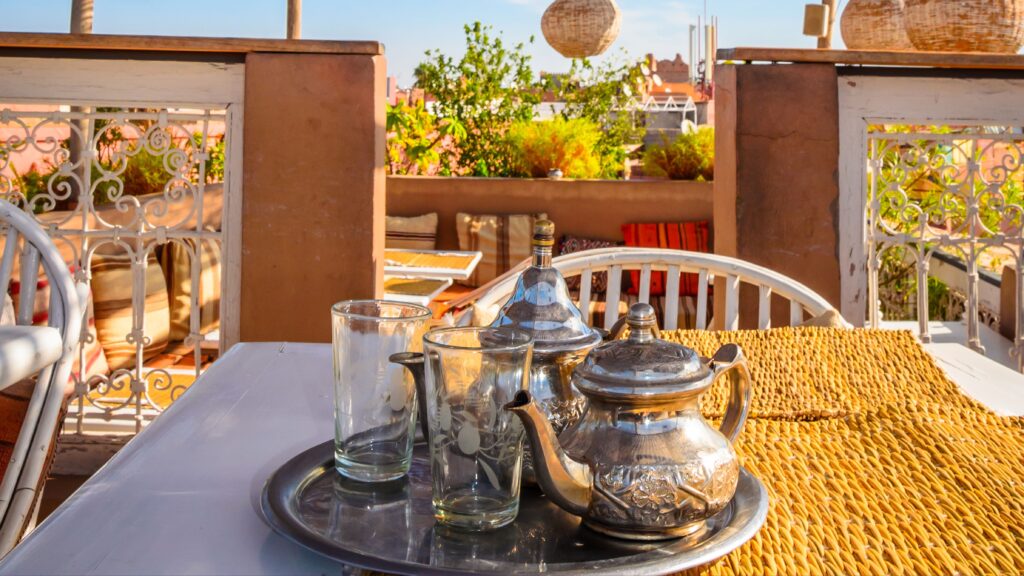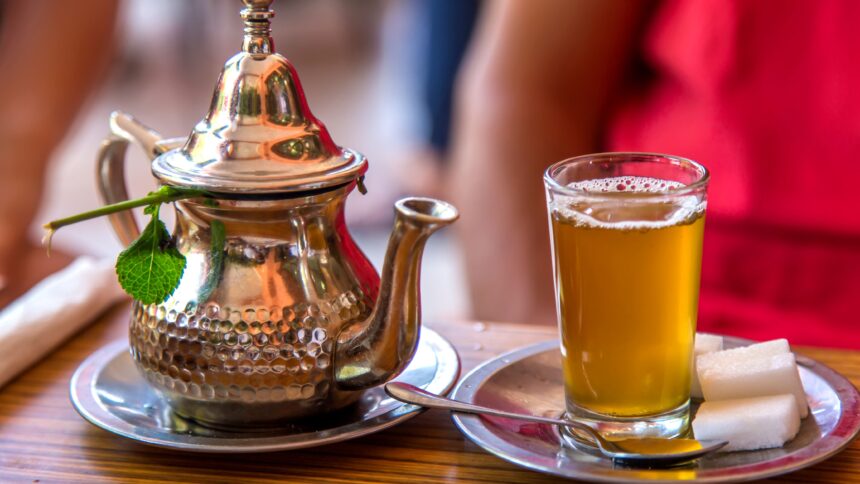Greetings, esteemed tea enthusiast! I am the Herbal Tea Master, ready to share with you the wonders of traditional Moroccan mint tea. Allow me to guide you through the steps of crafting this delightful beverage, while also delving into its rich history and health benefits.
Moroccan mint tea, also known as “Maghrebi mint tea” or “Moroccan tea ceremony,” is a beloved beverage in Moroccan culture. It is a timeless tradition that brings people together and offers a refreshing respite from the bustling world. In this article, we will explore the art of crafting traditional Moroccan mint tea, including its ingredients, preparation process, and the health benefits it provides.
Ingredients:
To make traditional Moroccan mint tea, you will need the following ingredients:
- Fresh Moroccan mint leaves (a generous handful)
- Green tea leaves (1 tablespoon)
- Water (4 cups)
- Granulated sugar (to taste)
Preparation Process:
- Boil the water: Pour the water into a teapot and bring it to a rolling boil.
- Rinse the teapot: Pour a small amount of boiling water into the teapot, swish it around, and discard it. This step helps to warm the teapot and improve the taste of the tea.
- Add the green tea leaves: Place the green tea leaves into the teapot.
- Add the mint leaves: Add the fresh mint leaves to the teapot, gently pressing them with a wooden spoon or muddler to release their aromas.
- Steep the tea: Pour the boiling water into the teapot and let the tea steep for about 2-3 minutes. This allows the flavors to infuse into the water.
- Sweeten to taste: Moroccan mint tea is traditionally served sweet. Add granulated sugar to the teapot and stir until it dissolves. Start with a small amount and adjust according to your preference.
- Serve and enjoy: Pour the tea into small, heat-resistant glasses from a height to create a frothy layer on top. This traditional pouring technique is called “high pouring.” Serve the tea alongside small treats or Moroccan pastries for an authentic experience.
Health Benefits and Study Cases:

Digestive Aid:
- Mint leaves have been used for centuries to support digestion and ease digestive discomfort.
- A study published in the Journal of Gastroenterology and Hepatology found that peppermint oil, which is abundant in Moroccan mint, can help relieve symptoms of irritable bowel syndrome (IBS) such as abdominal pain and bloating.
Antioxidant Boost:
- Green tea leaves are rich in antioxidants, which help protect the body against damage caused by harmful free radicals.
- According to a study published in the Journal of Medicinal Food, green tea consumption is associated with a reduced risk of chronic diseases such as cardiovascular disease and certain types of cancer.
Mental Clarity and Relaxation:
- The combination of green tea and mint leaves can promote mental clarity and relaxation.
- A study published in the Journal of Pharmacological Research suggests that green tea intake may enhance cognitive function and improve attention and memory.
Conclusion:
Traditional Moroccan mint tea is not only a delicious and refreshing beverage but also offers numerous health benefits. By following the steps outlined in this article, you can create an authentic Moroccan tea experience in the comfort of your own home. So, gather your friends, prepare some delectable Moroccan treats, and savor the aromatic delight of this centuries-old tradition.
Remember, each cup of Moroccan mint tea is an invitation to slow down, connect with the present moment, and nourish your body and soul. Enjoy your tea journey!
FAQs
What is Moroccan mint green tea good for?
Moroccan mint green tea offers not only a delightful taste but also several potential health benefits. Let’s explore some of the benefits associated with this refreshing beverage:
- Digestive Health: Moroccan mint green tea, particularly due to the presence of mint, is known to have digestive benefits. It may help soothe an upset stomach, relieve indigestion, and reduce symptoms of bloating and gas.
- Antioxidant Properties: Green tea, the base of Moroccan mint green tea, is rich in antioxidants called catechins. These antioxidants help protect the body against damage from harmful free radicals and may contribute to overall health and well-being.
- Mental Focus and Alertness: The combination of green tea and mint in Moroccan mint tea can provide a gentle energy boost and enhance mental focus. The natural caffeine content in green tea, along with the refreshing aroma of mint, may help improve alertness and cognitive performance.
- Relaxation and Stress Relief: Mint is known for its calming properties, and sipping on Moroccan mint green tea can help promote relaxation and reduce stress levels. The soothing aroma and flavor of mint can have a positive impact on mood and overall well-being.
- Hydration: Staying hydrated is essential for overall health, and Moroccan mint green tea can contribute to your daily fluid intake. It provides a flavorful and refreshing alternative to plain water, making it an enjoyable way to stay hydrated.
It’s important to note that while Moroccan mint green tea has potential health benefits, individual experiences may vary. It’s always a good idea to consult with a healthcare professional for personalized advice.
How much caffeine is in Moroccan mint green tea?
Ah, the enchanting Moroccan mint green tea! It’s a delightful beverage that combines the invigorating flavors of green tea and refreshing mint. Now, let’s explore the caffeine content in this delightful blend.
Green tea, including Moroccan mint green tea, naturally contains caffeine, albeit in lower amounts compared to black tea or coffee. On average, an 8-ounce cup of Moroccan mint green tea contains approximately 25-30 milligrams of caffeine. However, it’s important to note that the caffeine content can vary depending on factors such as the brewing time, water temperature, and the specific type and quality of tea leaves used.
The caffeine in green tea provides a gentle energy boost without the jitters often associated with coffee. It can help improve focus, enhance cognitive function, and provide a sense of alertness. Additionally, green tea is also rich in antioxidants and offers various health benefits, including supporting heart health, boosting metabolism, and promoting overall well-being.
If you’re sensitive to caffeine or prefer to minimize your intake, you can choose to steep your Moroccan mint green tea for a shorter duration or opt for decaffeinated varieties. However, keep in mind that decaffeinated green tea may still contain trace amounts of caffeine.
Remember, moderation is key when enjoying any caffeinated beverage. So, sit back, relax, and savor the delightful flavors of Moroccan mint green tea without worrying about excessive caffeine intake. Enjoy your tea time!
What type of mint is used in Moroccan tea?
Moroccan tea, also known as Moroccan mint tea or Atay Bi Nana, is a popular beverage in Morocco. It is made by steeping green tea with a generous handful of mint leaves. While spearmint is the most commonly used mint in Moroccan tea, other types of mint or herbs may also be used to enhance the flavor. Here are some types of mint that are commonly used in Moroccan tea:
- Spearmint: Spearmint is the most traditional and widely used mint in Moroccan tea. It has a refreshing and slightly sweet flavor that complements the green tea.
- Nanah Mint: Nanah mint, also known as Moroccan mint or Mentha spicata, is a specific type of mint that is commonly used in Moroccan cuisine and tea. It has a strong and aromatic flavor, which adds a unique taste to the tea.
- Peppermint: Peppermint, with its strong and cooling flavor, is sometimes used in Moroccan tea to add a minty kick. It can provide a refreshing and invigorating taste to the tea.
- Other herbs: In addition to different types of mint, other herbs may also be added to Moroccan tea to enhance its flavor. Some common herbs used include artemisia and sage, especially during the winter season.
Learn more:




